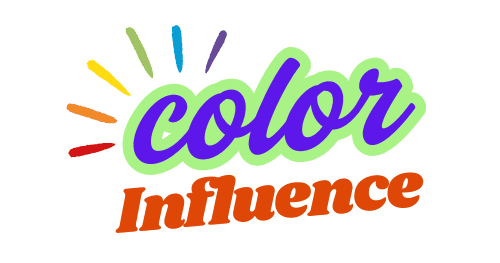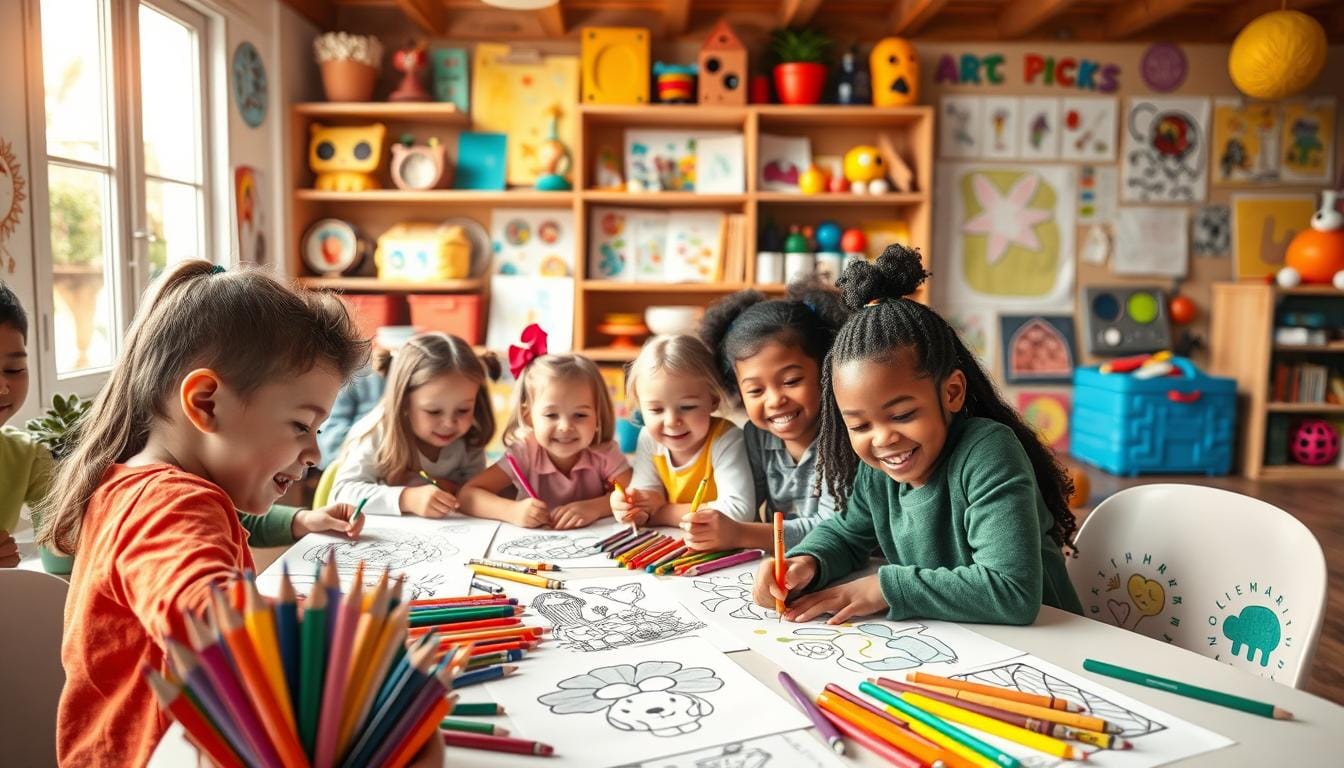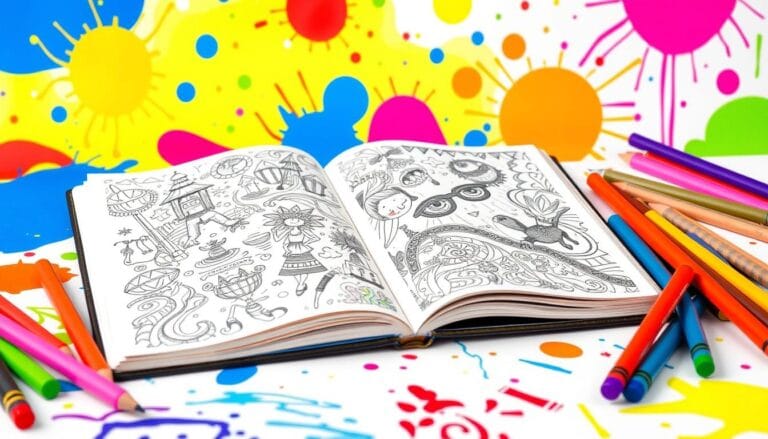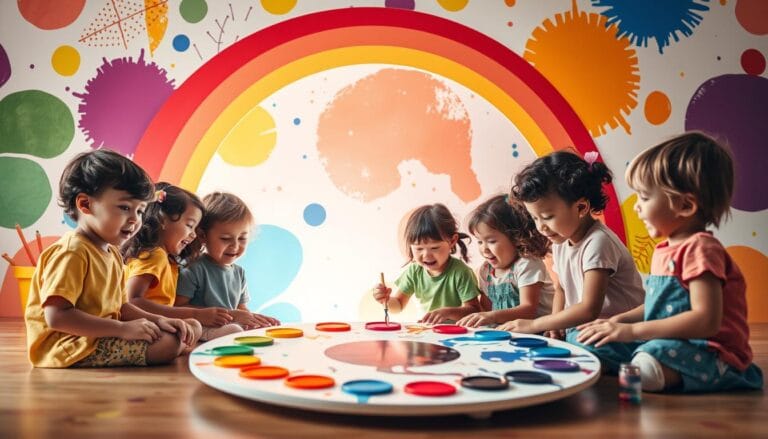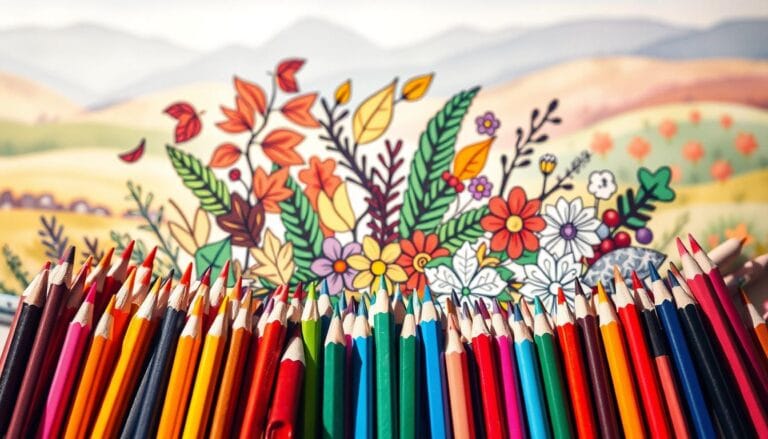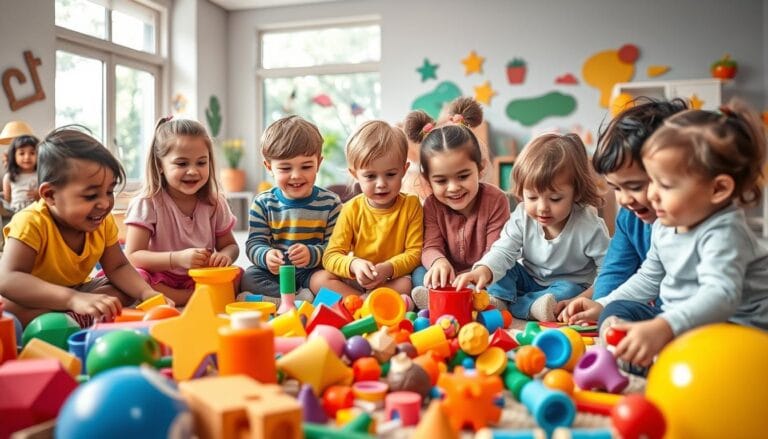Boost Your Child’s Creativity with These Exciting Coloring Activities
Every parent knows the magic of a child picking up a crayon. These moments turn ordinary pages into vibrant worlds of imagination. Coloring is more than just filling spaces with color—it’s a powerful tool for growing up.
These coloring activities do more than just spark creativity. They let children explore their feelings, learn important skills, and express themselves in ways words can’t. From learning about color theory to improving fine motor skills, coloring is a journey of discovery.
Imagine seeing your child’s face light up as they turn a blank page into a masterpiece. Through coloring, kids learn to communicate, focus, and grow confident—all while having fun.
The Power of Coloring: Understanding Its Impact on Child Development
Coloring is more than a fun activity for kids. It’s a powerful tool that helps with important skills and mental health. Studies show how coloring can greatly impact a child’s growth and emotional health.
Coloring is a special form of art therapy for kids. It lets them explore their inner world and develop key skills. Let’s look at how this activity can change a child’s life.
Enhancing Fine Motor Skills Through Regular Practice
When kids hold a crayon or colored pencil, they’re doing more than making art. They’re improving their fine motor skills, which are vital for life. Regular coloring strengthens:
- Wrist muscle coordination
- Finger dexterity
- Hand-eye precision
- Grip strength
Building Concentration and Focus
Coloring is a great way for kids to relax and focus. It helps them stay on one task for a long time. Studies show that colors can make the brain work better and help with learning.
| Color | Cognitive Impact |
|---|---|
| Blue | Enhances creativity and imagination |
| Green | Promotes concentration and focus |
| Yellow | Stimulates mental activity |
Fostering Emotional Expression
Coloring is a powerful way for kids to share their feelings. It lets them express emotions they might not be able to say out loud. It’s a safe way for them to explore and manage their feelings.
By making coloring a part of your child’s daily life, you’re helping their mental health, creativity, and growth. It’s a fun and engaging way to support their development.
Essential Benefits of These Exciting Coloring Activities
Discover the amazing benefits of these exciting coloring activities. They do more than just entertain. They help your child grow in many ways.
Coloring is a special way for kids to explore their feelings. It helps them relax and focus. This makes them feel calm and improves their ability to handle emotions.
- Reduce stress and anxiety
- Improve concentration
- Develop emotional regulation skills
These coloring activities are key for kids to develop important skills. They help kids get better at using their hands and eyes together. Studies show that coloring can also make kids smarter at solving problems and making decisions.
Coloring helps kids make memories that last a lifetime. As they play with colors and shapes, they learn to think critically and be creative. Each picture they make shows how far they’ve come, boosting their confidence and creativity.
Coloring also helps kids in other ways. It:
- Improves color recognition
- Enhances spatial reasoning
- Increases patience and focus
- Provides an emotional outlet
By making coloring a part of your child’s daily life, you’re giving them more than just a fun activity. You’re opening doors to new learning and growth.
Setting Up the Perfect Creative Space for Your Child
Creating a space for your child’s art is key. It turns coloring into a special time that helps them grow. A good space makes coloring more than just a hobby.
Design is important for a creative area. Kids need a place that feels right and sparks their creativity. It should be a space that invites them to explore.
Choosing the Right Materials and Tools
Choosing the right art supplies is crucial. Think about these things:
- Tools that fit their age
- Different kinds of paper
- Coloring tools that are easy to hold
- Stuff that’s safe and won’t harm them
Creating a Comfortable Coloring Environment
The space should be comfy and useful. Good lighting, comfy seats, and few distractions help a lot.
| Environment Factor | Recommended Setup |
|---|---|
| Lighting | Natural light near a window |
| Seating | Adjustable child-sized chair |
| Surface | Stable, clean table or desk |
Organizing Supplies for Easy Access
Organizing supplies makes art fun and easy. Use bins, labels, and shelves that kids can reach. It helps them get what they need without help.
- Color-coded storage bins
- Low, child-height shelves
- Rolling art carts
- Magnetic boards for displaying artwork
Designing a great space for your child’s art is rewarding. It supports their creativity and makes relaxation fun.
From Simple to Complex: Age-Appropriate Coloring Pages
Choosing the right coloring activities for your child can turn them into a magical journey of creativity and learning. Each age group has its own needs, making it important to pick coloring pages that are both fun and challenging.
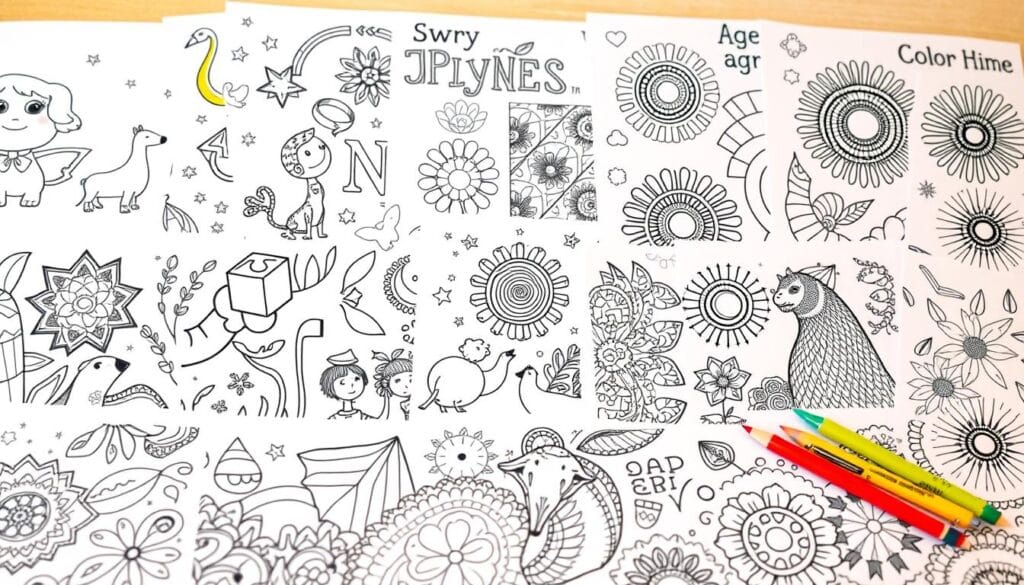
For toddlers aged 2-3, simple coloring pages are best. These pages should have:
- Large objects with clear outlines
- Minimal details to prevent overwhelming young learners
- Recognizable shapes and characters
As children grow, their coloring skills get better. Preschoolers aged 4-5 enjoy more diverse coloring experiences. Childhood memories often start with these early artistic explorations. They help develop fine motor skills and concentration.
Coloring is not just an activity, it’s a developmental tool that nurtures creativity and learning.
For children aged 6-7, the pages get more complex. These exciting coloring activities can include:
- Intricate designs with multiple details
- Educational themes like mathematical coloring books
- Dot-to-dot challenges that enhance problem-solving skills
Adult coloring books have also become popular. Parents can share their coloring experiences with their kids. This creates a fun connection through art between generations.
Unleashing Imagination Through Themed Coloring Sessions
Coloring becomes a magical journey when kids explore themed pages. These pages spark their creativity. They open doors to vibrant worlds where imagination has no limits. By choosing engaging themes, you can make simple hobbies into lasting memories.
Themed coloring sessions offer exciting opportunities for kids to explore different creative landscapes. Let’s dive into some captivating themes that will keep your child inspired:
Animal Adventures and Nature Scenes
Bring wildlife and natural landscapes to life through colorful illustrations. Kids can transform:
- Majestic lions in their savanna habitat
- Playful dolphins swimming in crystal waters
- Intricate forest scenes with detailed wildlife
Holiday and Seasonal Celebrations
Seasonal themes provide perfect opportunities for artistic expression. Exciting coloring pages can include:
- Halloween monster designs
- Christmas winter wonderlands
- Spring flower and Easter bunny scenes
Fantasy and Superhero Designs
Imagination soars with fantasy and superhero-themed coloring pages. These designs allow kids to:
- Create unique color combinations for magical creatures
- Explore superhero universes through vibrant illustrations
- Develop storytelling skills while coloring
Research shows that 90% of parents find themed coloring activities help facilitate discussions about colors, shapes, and creativity. By engaging in these immersive coloring experiences, kids can develop critical cognitive skills while having tremendous fun.
Incorporating Art Therapy Elements into Daily Coloring
Art therapy is a powerful way for kids to explore their feelings and improve their mental health. It turns coloring into a way to relax and understand their emotions better.
Adding art therapy to daily coloring helps kids become more emotionally strong and aware. It lets them share feelings they might find hard to say out loud. This makes a safe space for them to express their emotions.
- Use color to represent emotions
- Create mood-based coloring sessions
- Encourage free-form artistic expression
- Practice mindful coloring techniques
Studies show that just under an hour of creative activities can lower stress and boost mental health. Art therapy helps kids:
| Skill Developed | Emotional Benefit |
|---|---|
| Emotional Expression | Release of inner tensions |
| Self-Awareness | Understanding personal feelings |
| Stress Management | Reduced anxiety levels |
When doing art therapy-inspired coloring, focus on the journey, not the end result. Encourage your child to play with colors, try new techniques, and be creative. This turns coloring into a tool for mental health support.
Art is a language without words, allowing emotions to speak when communication feels challenging.
Making Coloring a Social Activity: Group Projects and Sharing
Coloring turns from a solo hobby into a fun group activity. It creates lasting memories for kids. They learn to share and create together.
Group coloring helps kids grow socially. Studies show 80% of students feel more connected in team projects. They learn to communicate better and make friends.
Collaborative Coloring Projects
There are many fun group coloring projects:
- Classroom mural projects
- Themed coloring challenges
- Community art installations
- Multi-panel storytelling artwork
Family Coloring Time Benefits
Family coloring clubs are very effective. About 85% of families say they strengthen bonds. They create special moments and memories.
Sharing and Displaying Artwork
Showing off artwork boosts kids’ confidence. Start a family gallery wall or digital showcase. It lets everyone see and enjoy each other’s art.
Creativity flourishes when shared with others!
75% of students learn to value each other’s work in group projects. Coloring becomes a way to build empathy, communication, and respect.
Digital vs. Traditional Coloring: Finding the Right Balance
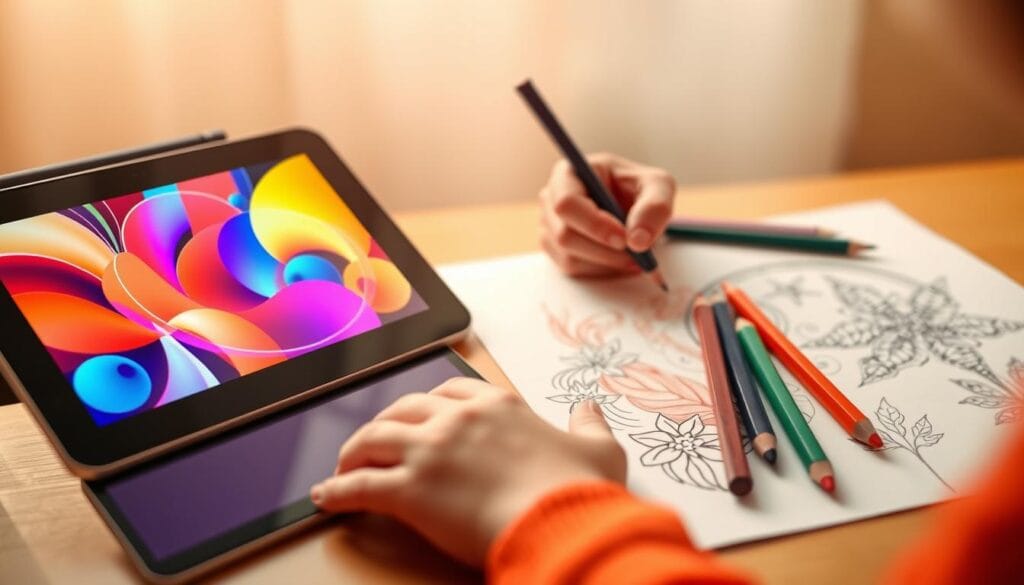
In today’s world, parents have a fun challenge. They must choose between digital and traditional coloring for their kids. Both have special benefits that boost creativity and help with relaxation.
Traditional coloring lets kids feel the texture of crayons or pencils. It’s a hands-on way to improve fine motor skills. Studies show it can make kids focus better by up to 60% than other learning methods.
- Traditional coloring develops hand-eye coordination
- Digital platforms offer unlimited color options
- Physical coloring supports sensory development
- Digital tools provide instant creativity and correction
Digital coloring has its perks too. It’s mess-free, has endless colors, and is great for kids who love tech. Interactive digital coloring apps make these activities fun and engaging.
The best approach is to mix both digital and traditional coloring. This keeps things interesting for your child. It lets them enjoy the benefits of both worlds, keeping their creativity and relaxation practices alive.
Creativity knows no boundaries – whether digital or traditional, coloring remains a powerful tool for child development.
Conclusion: Nurturing Creativity One Page at a Time
These coloring activities are more than just fun—they help grow your child’s creativity and personal growth. Studies show that 80% of adults who color regularly feel more focused. Also, 70% of families say coloring together makes their home a calmer place.
Coloring is great for mental health, offering benefits beyond just fun. Kids who color are 50% more likely to be patient and resilient. By coloring, you’re helping your child develop important skills, improve hand-eye coordination, and connect emotionally.
Supporting your child’s creative journey can create lasting memories. 90% of parents find that coloring sessions lead to deep conversations. This strengthens family bonds and helps your child grow in many ways.
Begin today. Use these coloring activities to learn, bond, and discover together. See your child’s confidence soar, their imagination grow, and their view of the world brighten up—one colorful page at a time.
FAQ
At what age can children start coloring?
Kids can start simple coloring at 18 months to 2 years old. They begin with scribbles and get better at controlling their movements. By 3-4 years, they can hold tools better and make more intentional designs.
How does coloring benefit my child’s development?
Coloring boosts fine motor skills, hand-eye coordination, and concentration. It also helps with emotional expression and decision-making. It’s a way for kids to express themselves and relax.
What types of coloring materials are best for children?
Use tools like large pencils for toddlers, washable markers for preschoolers, and regular pencils or crayons for older kids. Make sure they’re safe, easy to hold, and match your child’s skill level.
How can coloring help with my child’s emotional well-being?
Coloring is a great way for kids to deal with emotions and stress. It helps them express feelings they can’t say out loud. It’s calming and helps with anxiety and emotional challenges.
Are digital coloring apps as beneficial as traditional coloring?
Both digital and traditional coloring have their own benefits. Traditional coloring improves fine motor skills, while digital offers endless colors and fun features. It’s good to mix both for a well-rounded creative experience.
How can I make coloring more engaging for my child?
Make coloring fun by using themes like animals or holidays. Color together and show off their work. Invite friends or make it a family activity. Change up the coloring pages to keep things interesting.
Can coloring help children with learning difficulties?
Yes, coloring is great for kids with learning challenges. It helps with focus, patience, and expression. It’s especially helpful for kids with attention deficit or sensory issues.
How long should a typical coloring session last?
The length of a coloring session varies by age and attention span. Toddlers do well with 10-15 minutes, while older kids can color for 30-45 minutes. Watch for signs of tiredness or frustration and keep it fun.
